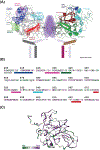Structural perspectives on HCV humoral immune evasion mechanisms
- PMID: 34091143
- PMCID: PMC8319080
- DOI: 10.1016/j.coviro.2021.05.002
Structural perspectives on HCV humoral immune evasion mechanisms
Abstract
The molecular mechanisms of hepatitis C virus (HCV) persistence and pathogenesis are poorly understood. The design of an effective HCV vaccine is challenging despite a robust humoral immune response against closely related strains of HCV. This is primarily because of the huge genetic diversity of HCV and the molecular evolution of various virus escape mechanisms. These mechanisms are steered by the presence of a high mutational rate in HCV, structural plasticity of the immunodominant regions on the virion surface of diverse HCV genotypes, and constant amino acid substitutions on key structural components of HCV envelope glycoproteins. Here, we review the molecular basis of neutralizing antibody (nAb)-mediated immune response against diverse HCV variants, HCV-steered humoral immune evasion strategies and explore the essential structural elements to consider for designing a universal HCV vaccine. Structural perspectives on key escape pathways mediated by a point mutation within the epitope, allosteric modulation of the epitope by distant mutations and glycan shift on envelope glycoproteins will be highlighted (abstract graphic).
Copyright © 2021 Elsevier B.V. All rights reserved.
Conflict of interest statement
Declaration of interests
The authors declare that they have no known competing financial interests or personal relationships that could have appeared to influence the work reported in this paper.
Figures



References
-
- Choo QL, Kuo G, Weiner AJ, Overby LR, Bradley DW, Houghton M: Isolation of a Cdna Clone Derived from a Blood-Borne Non-a, Non B Viral-Hepatitis Genome. Science 1989, 244:359–362. - PubMed
-
- Houghton M: Discovery of the hepatitis C virus. Liver International 2009, 29:82–88. - PubMed
-
- Bukh J: The history of hepatitis C virus (HCV): Basic research reveals unique features in phylogeny, evolution and the viral life cycle with new perspectives for epidemic control. Journal of Hepatology 2016, 65:S2–S21. - PubMed
-
- McKnight-Eily LRO CA; Strine TW; Verlenden J; Hollis NT; Njai R; Mitchell EW; Board A; Puddy R; Thomas C;: Racial and Ethnic Disparities in the Prevalence of Stress and Worry, Mental Health Conditions, and Increased Substance Use Among Adults During the COVID-19 Pandemic — United States, April and May 2020. Morbidity and Mortality Weekly Report 2021, 70:162–166. - PMC - PubMed
Publication types
MeSH terms
Substances
Grants and funding
LinkOut - more resources
Full Text Sources

